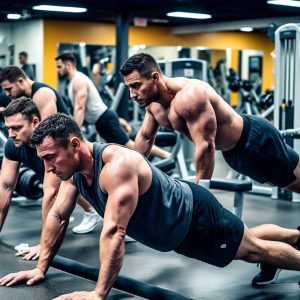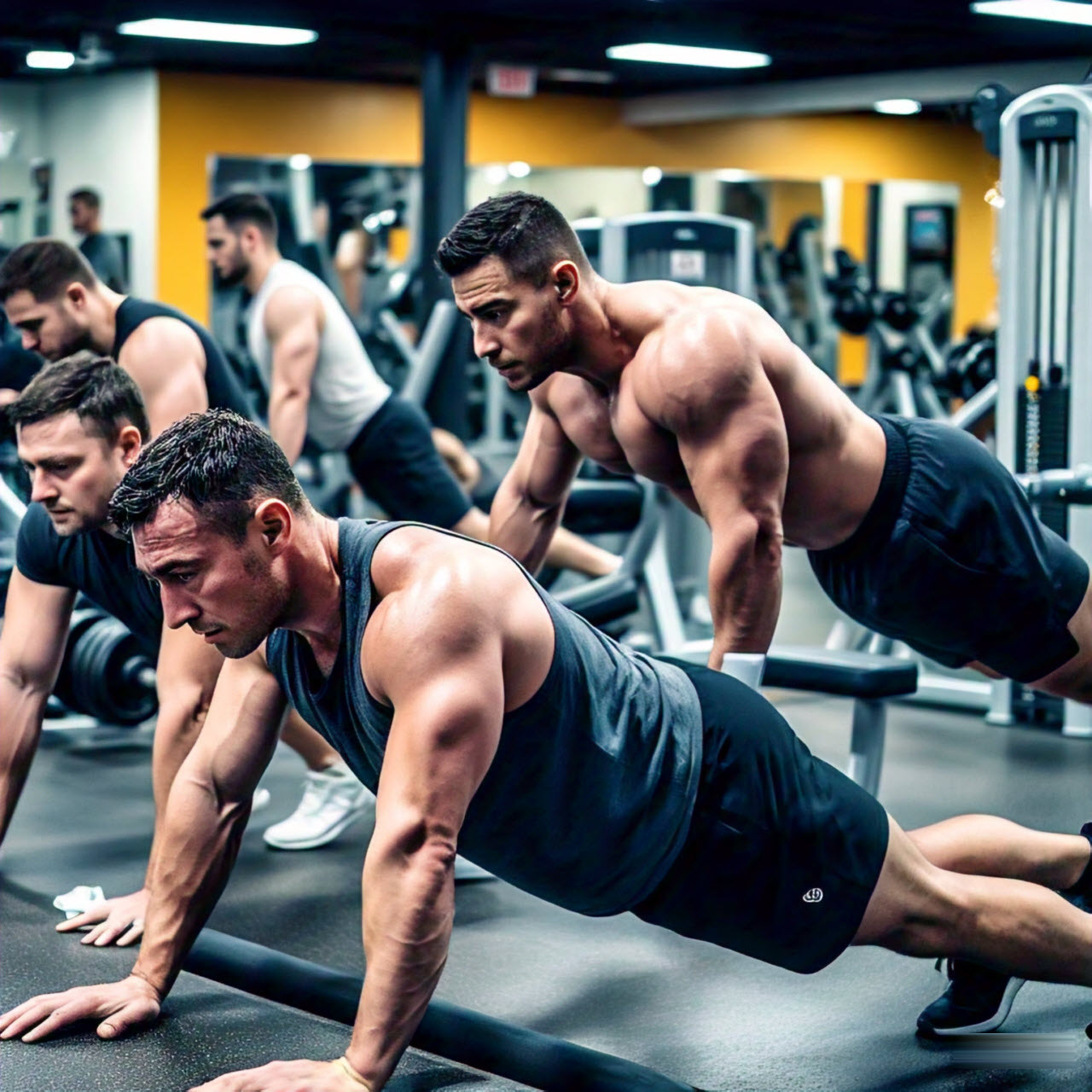 In a world where quick fixes and fleeting fitness trends dominate, the real challenge lies in building a routine that lasts. A sustainable fitness and health routine isn’t just about achieving short-term goals; it’s about creating habits that become second nature, ensuring long-term success and well-being.
In a world where quick fixes and fleeting fitness trends dominate, the real challenge lies in building a routine that lasts. A sustainable fitness and health routine isn’t just about achieving short-term goals; it’s about creating habits that become second nature, ensuring long-term success and well-being.
Creating a routine that works for you—one that balances physical activity, proper nutrition, and mental well-being—is key to achieving lasting results. This guide provides actionable steps and insights to help you design a fitness and health plan tailored to your lifestyle. Whether you’re starting from scratch or refining an existing routine, this guide has you covered.
Why Sustainability Matters
Fitness fads and extreme diets may promise rapid results, but they often fail to deliver lasting change. According to the World Health Organization (WHO), insufficient physical activity is one of the leading risk factors for global mortality, contributing to millions of preventable deaths each year. The truth is that real progress comes from consistency and sustainability—not short bursts of effort.
The Benefits of Consistent Effort
Research from the Journal of Fitness and Public Health shows that moderate, consistent exercise significantly improves cardiovascular health, reduces stress, and boosts energy levels. It also reduces the risk of chronic illnesses like diabetes and hypertension. Importantly, sustainability in fitness isn’t just about physical health; it also plays a vital role in mental well-being.
When you commit to a sustainable routine, you’re not just working toward a goal—you’re transforming your lifestyle. This guide will help you build a foundation that supports your body and mind for years to come.
Building the Foundation – Your Workout Plan
Every great fitness journey starts with a plan, and the foundation of any plan is balance. You need cardio for endurance, strength training for muscle development, and flexibility exercises to keep your body moving freely.
When I first started working out, I went all-in on cardio, running five miles a day. Sure, I shed some pounds, but I wasn’t building strength or addressing my tight hamstrings. It wasn’t until I embraced a balanced routine that I saw lasting results—and felt amazing doing it.
Cardio: The Heart of Fitness
Cardio is the powerhouse of any fitness routine. It strengthens your heart, improves endurance, and burns calories efficiently. Activities like running, swimming, and cycling are fantastic options, but you don’t need fancy equipment to get started. A simple jump rope can deliver a killer cardio workout in just 15 minutes.
According to the CDC, adults should aim for 150 minutes of moderate cardio or 75 minutes of vigorous activity weekly. That might sound like a lot, but when broken into 30-minute sessions, it’s entirely manageable. Plus, the benefits—lower blood pressure, improved stamina, and a better mood—are more than worth it.
Strength Training: Build Your Powerhouse
Strength training isn’t just for bodybuilders. It’s for anyone who wants to burn more calories, improve posture, and stay active as they age. When I started lifting weights, I was intimidated by the gym, so I began with bodyweight exercises at home: squats, push-ups, and lunges. Those small steps built my confidence—and my muscles.
As you progress, consider adding tools like the Bowflex SelectTech 552 Adjustable Dumbbells. These versatile dumbbells replace an entire rack of weights, saving space while giving you room to grow stronger.
Flexibility and Mobility: The Missing Link
Flexibility and mobility are often overlooked, but they’re vital for preventing injuries and improving performance. Stretching after workouts or incorporating yoga can make a world of difference. Poses like downward dog and child’s pose aren’t just for yogis—they’re for anyone who wants to feel good in their own skin.
Investing in a durable yoga mat can make these sessions more comfortable and keep you committed. Plus, stretching doesn’t just benefit your body—it’s a chance to pause and breathe after a long day.
A balanced workout plan isn’t just about results; it’s about enjoying the process. When you find exercises you love, consistency becomes second nature—and that’s where the magic happens.
Recovery – The Unsung Hero of Fitness
You can push yourself to the limit in every workout, but without proper recovery, progress will stall. Recovery isn’t a luxury; it’s the secret weapon behind every sustainable fitness routine.
I learned this the hard way. Early in my fitness journey, I believed more workouts meant faster results. But after weeks of fatigue and nagging injuries, I realized I was ignoring the critical role recovery plays. Once I started prioritizing rest and repair, everything changed—my energy, performance, and even my mood improved.
Sleep: The Foundation of Recovery
Sleep isn’t just for dreamers—it’s where the magic of muscle repair and growth happens. The National Sleep Foundation recommends 7–9 hours of sleep per night for optimal recovery and overall well-being. During deep sleep, your body releases growth hormones that repair muscles and replenish energy stores.
Struggling with sleep? Create a bedtime routine by minimizing screen time, keeping your bedroom cool and dark, and considering relaxation techniques like meditation. Small changes can lead to big results.
Hydration: Fueling Recovery
Water is the lifeblood of recovery. It lubricates joints, aids digestion, and helps transport nutrients to your muscles. Aim to drink at least 8–10 cups daily, adjusting based on your activity level and climate.
During intense workouts, electrolytes can make a significant difference. They replenish minerals lost through sweat, ensuring your muscles continue to function optimally.
Active Recovery: Moving to Heal
Active recovery might sound counterintuitive, but light movement can do wonders for reducing soreness and improving circulation. Activities like walking, yoga, or even a leisurely bike ride help flush out lactic acid and keep you limber.
For targeted muscle relief, tools like the LifePro Rumblex Plus 4D Vibration Plate Exercise Machine are game-changers. This device enhances blood flow, speeds up recovery, and even strengthens muscles—all while you relax.
Foam Rolling: Your Personal Massage
If you’ve ever felt tightness in your muscles after a workout, foam rolling can be a lifesaver. Using a tool like the TriggerPoint GRID Foam Roller, you can release tension, improve mobility, and reduce the risk of injuries. It’s like having a personal massage therapist at your fingertips.
Recovery isn’t a passive process—it’s an active choice. By prioritizing sleep, hydration, and tools that support your body’s needs, you’ll not only feel better but also maximize the benefits of your hard work.
Nutrition – Fueling Your Journey
What you eat is just as important as how you move. Nutrition is the fuel that powers your workouts, supports recovery, and keeps your body functioning at its best. Without it, even the most disciplined fitness routine will fall short.
I used to think that working out was enough to stay healthy. I’d grab whatever was quick and easy, not realizing how much it impacted my energy and performance. Once I started paying attention to what I ate, everything changed—my workouts improved, I recovered faster, and I just felt better overall.
The Pillars of a Balanced Diet
A balanced diet isn’t about restriction; it’s about variety. Your body thrives on a mix of macronutrients:
- Protein: Builds and repairs muscle. Great sources include lean meats, eggs, tofu, and legumes.
- Carbohydrates: Your main energy source. Opt for whole grains, fruits, and vegetables.
- Healthy Fats: Essential for brain function and hormone production. Think avocados, nuts, and olive oil.
To ensure you’re getting the right nutrients, focus on whole, minimally processed foods. Keep it simple: if it grew from the ground or had a mother, it’s probably a good choice.
Meal Prep for Success
Consistency is easier when you’re prepared. Meal prepping is a game-changer, especially on busy days. Spending an hour or two each week planning and preparing meals can save time and help you avoid unhealthy choices.
Glass meal prep containers are an excellent investment for storing pre-portioned meals. I’ve found that having healthy options ready to go eliminates the temptation to reach for junk food.
Post-Workout Nutrition
What you eat after a workout can make or break your recovery. Aim for a mix of protein and carbohydrates within 30 minutes of exercising to replenish glycogen stores and support muscle repair.
One of my go-to options is a smoothie made with spinach, a banana, almond milk, and a scoop of protein powder. Blending it all in a Ninja Blender is quick, easy, and incredibly satisfying.
Supplements: Filling the Gaps
While whole foods should always be your priority, supplements can help fill in nutritional gaps. Common options include whey protein, multivitamins, and omega-3 fish oil. However, it’s essential to consult with a healthcare professional before introducing new supplements to your diet.
Proper nutrition is about more than just hitting calorie targets—it’s about giving your body the tools it needs to thrive. When you prioritize balanced meals and mindful eating, you’ll see and feel the difference in every aspect of your fitness journey.
Mindset and Mental Resilience
Fitness isn’t just physical—it’s deeply mental. The right mindset can mean the difference between giving up and showing up, even on the tough days. Building mental resilience is as critical as any workout or meal plan.
I remember a time when I was stuck in a cycle of starting and stopping. Every missed workout felt like a failure, and I’d lose momentum quickly. It wasn’t until I shifted my mindset—focusing on progress, not perfection—that I found my rhythm. That change was the real breakthrough.
Why Mental Fitness Matters
Physical health and mental health are inseparable. Exercise releases endorphins, the “feel-good” hormones that reduce stress and improve mood. According to the American Psychological Association, regular physical activity is one of the most effective tools for managing stress and enhancing emotional resilience.
But mental fitness goes beyond the benefits of exercise. It’s about training your mind to stay focused, motivated, and adaptable in the face of challenges.
Consistency Over Perfection
Perfection is a myth. Life happens—there will be days when workouts are skipped or meals aren’t ideal. What matters is the ability to get back on track. Think of your fitness journey like a long hike: one stumble doesn’t ruin the entire climb.
To build consistency, set realistic goals and celebrate small victories. Even 10 minutes of movement counts. It’s not about doing everything perfectly; it’s about showing up more often than not.
Mindfulness and Focus
Practicing mindfulness can help you stay present and reduce distractions. Techniques like meditation, journaling, or even taking a few deep breaths before a workout can make a huge difference.
Apps like Calm or Headspace provide guided meditation sessions tailored for beginners. Pairing mindfulness with your fitness routine helps you stay grounded and connected to your goals.
Overcoming Setbacks
Setbacks are inevitable, but they don’t define your journey. Instead of viewing them as failures, see them as opportunities to learn and adjust. Reflect on what went wrong—was it a lack of time, motivation, or planning? Then, create a strategy to prevent the same issue in the future.
A fitness tracker like the Fitbit Charge 6 can help you stay accountable and track progress, even during challenging times. Small wins, like hitting a step goal or improving sleep quality, can reignite your motivation.
Building Resilience
Resilience is like a muscle—it grows stronger with practice. Surround yourself with supportive people, whether it’s a workout buddy, a coach, or an online community. Sharing your goals and challenges makes the journey less lonely and more rewarding.
Finally, remember your “why.” Why did you start this journey? Keep that reason front and center, especially on tough days. When you align your actions with your deeper purpose, it becomes easier to stay on course.
Mindset isn’t just an accessory to fitness—it’s the backbone. Cultivate a resilient, focused mindset, and you’ll not only transform your fitness journey but also every other area of your life.
Tracking Your Progress
What gets measured gets improved. Tracking your progress not only keeps you accountable but also provides tangible proof of how far you’ve come. It’s one of the most motivating aspects of a fitness journey.
When I started tracking my workouts and habits, I was amazed at how much it changed my perspective. Small wins—like shaving seconds off a mile or consistently getting eight hours of sleep—added up. Progress I might have overlooked suddenly felt like victories, and that kept me moving forward.
Why Tracking Matters
Progress isn’t always visible in the mirror, and that’s why data matters. Tracking helps you identify what’s working and where adjustments are needed. Whether it’s logging workouts, meals, or sleep patterns, the information you gather becomes a roadmap to success.
Research published in the CDC’s Physical Activity Guidelines shows that consistent tracking leads to better adherence and results. It’s a simple habit with powerful outcomes.
Tools for Tracking
There are countless ways to track your progress, from pen-and-paper journals to high-tech gadgets. As mentioned above, a fitness tracker like the Fitbit Charge 6 is a great option for monitoring steps, heart rate, and even sleep quality. It provides real-time feedback, helping you stay on track with your goals.
For strength training, keeping a workout log is invaluable. Record the exercises, sets, and weights you use each session. Over time, you’ll see how much stronger you’ve become—a boost that’s hard to ignore.
Celebrate the Small Wins
Fitness is a marathon, not a sprint. While long-term goals are important, celebrating small milestones keeps you motivated. Did you walk 10,000 steps every day this week? Fantastic. Hit a personal best on squats? Incredible. These moments matter, and they deserve recognition.
One of my favorite rewards is treating myself to something fitness-related—a new pair of running shoes, a durable water bottle, or even a book on training techniques. It’s a way to stay excited about the journey while reinforcing positive habits.
Reassess and Adjust
Your goals will evolve, and so should your approach. Maybe you started with a goal to lose weight but now want to focus on building muscle. Or perhaps you’ve realized you enjoy yoga more than running. Tracking allows you to pivot and refine your routine based on what works best for you.
Periodic check-ins are key. Look at your progress every few weeks and ask yourself: Am I moving closer to my goals? If not, what changes can I make? Flexibility is a strength in any fitness journey.
Tracking isn’t just about numbers—it’s about awareness. By paying attention to your habits, celebrating your achievements, and staying adaptable, you’ll set yourself up for long-term success. After all, fitness isn’t a destination; it’s a way of life.
Conclusion
A sustainable fitness and health routine isn’t built overnight—it’s a journey of small, intentional steps that add up to long-lasting results.
The key to success lies in balance. From crafting a workout plan that suits your lifestyle to fueling your body with nutritious meals and prioritizing recovery, each component of your routine plays an essential role. Equally important is cultivating a resilient mindset, tracking your progress, and celebrating the milestones—big or small—that mark your achievements.
Remember, this isn’t just about reaching a goal. It’s about creating a lifestyle that empowers you to feel stronger, healthier, and more confident every day. As you implement the strategies outlined in this guide, you’ll not only see the benefits but also feel them in every aspect of your life.
So, where will you start? Maybe it’s committing to three workouts a week or swapping out sugary snacks for whole foods. Wherever you begin, know that the journey is yours, and the rewards are worth it.
Looking for more inspiration? Check out our Modern Man’s Style Guide for practical tips on effortless dressing. Whether it’s fitness, style, or personal growth, we’re here to help you thrive.

